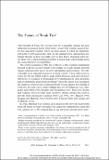The Future of Weak Ties
Author(s)
Aral, Sinan K
DownloadThe future of weak ties.pdf (524.4Kb)
PUBLISHER_POLICY
Publisher Policy
Article is made available in accordance with the publisher's policy and may be subject to US copyright law. Please refer to the publisher's site for terms of use.
Terms of use
Metadata
Show full item recordAbstract
“The Strength of Weak Ties” (Granovetter 1973) arguably contains the most influential sociological theory of networks. Granovetter’s subtle, nuanced theory has spawned countless follow-on ideas, many of which are immortalized in the 35,000 manuscripts that cite the original work. Among these are notable theories in their own right, such as Ron Burt’s structural holes theory (Burt 1992), which itself has generated a sizable body of knowledge about the social structure of competition.
Date issued
2016-05Department
Sloan School of ManagementJournal
American Journal of Sociology
Publisher
University of Chicago Press
Citation
Aral, Sinan. “The Future of Weak Ties.” American Journal of Sociology 121, no. 6 (May 2016): 1931–1939. © 2016 by The University of Chicago
Version: Final published version
ISSN
0002-9602
1537-5390